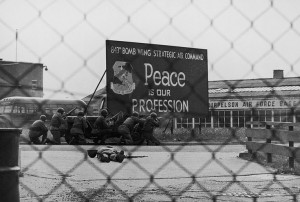Though generally a film coupled with live action shots and animation tends to lean towards cheesy or a children’s TV show that attempts to teach a moral lesson, Run Lola Run (1998) directed and written by Tom Tykwer, did a hell of a job in telling a story fit for a much different audience. The film is full of puns, hidden messages, motifs, and more, making it an incredibly gripping tale that is made stronger in my opinion by the inserted animations. Because of a reoccurring animated scene where the camera appears to jump into a TV, it is clear where the three versions of Lola’s (Franka Potente) stories begin.
This scene replays three times, each a little different. And these differences are significant in the tale. The first time we are introduced to Lola running down a winding staircase with a boy and a dog waiting at the top of one leg of it has camera zoom in on the dogs teeth. Upon asking what this may mean in class, somebody brought up the cliché “time nipping at your heels.” I interpreted it as another reference to the clock ticking away in Lola’s twenty minute adventure. During Lola’s second try at getting things right, the camera zooms in on the teeth of the boy. Another reference to time nipping at her heels, but this time it’s more about dealing with people to get her way, which turns out even worse than the first try when her conversation with her father (Herbert Knaup). She ends up robbing the bank. The third time this animation is replayed, Lola jumps over the barking dog and barks back, signaling that she will overcome time in this final attempt.
Something else I noticed from the start of the film, whether it was the red hair that set it off or the red phone, was the repetitive color scheme of the film. Reds. Greens. Yellows. Over and over and right in your face. Tykwer didn’t mean for it to be subtle, he meant to send a clear and unmistakable message–another reference to time. Red clearly means stop, and green means freedom or go, so yellow must fit right in to mean a slowing down of time or perhaps a tough decision that must be made. Just to reiterate the repetition: the red mise-en-scene includes Lola’s red hair, the phone, the tint over the screen while Lola and Manni (Moritz Bleibtreu) share a conversation while one of them is dying, red doors and windows, car, biker’s shirt, the Apotheke sign, designs on flags, and more. The green mise-en-scene includes the polizei, the bag, money, and the green picture. The yellow mise-en-scene includes the phone booth, yellow stores, train, and car. The emphasis on the essence of time is literally everywhere in the film, strengthening the message and film as a whole.

